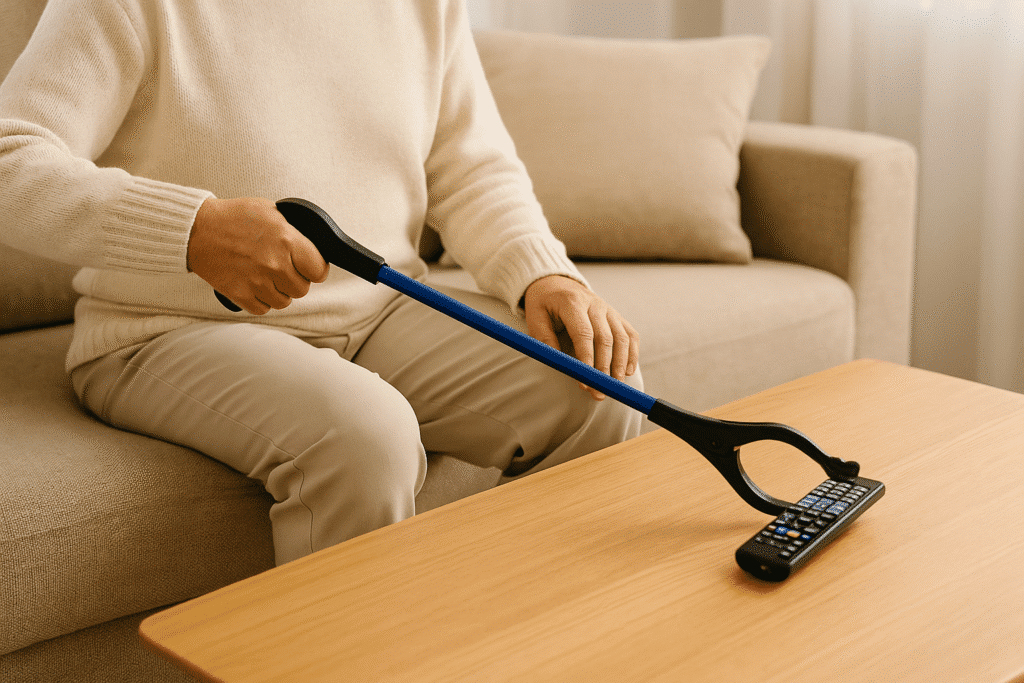Putting on compression socks for the elderly can feel tricky at first, but a simple method makes the process much easier.
I often help older adults with this task, and with the right steps, the socks glide on smoothly and feel comfortable throughout the day.
Key Summary:
To put on compression socks for the elderly, have the person sit comfortably, turn the sock inside out to the heel, slide the toes in, align the heel, and pull the sock up in small sections. Smooth out any wrinkles and make sure the sock feels firm but never painful. This helps the sock stay in place and work properly throughout the day.
What Compression Socks Do for Older Adults
Compression socks help support healthy blood flow, which is important for seniors who deal with swelling, tired legs, or long periods of sitting. The gentle pressure helps keep circulation moving and reduces discomfort.
They can also make daily activities a little easier. Many seniors I work with notice their legs feel lighter when they wear them consistently.
Here are a few key benefits:
- They help reduce swelling in the feet and legs.
- They support better circulation.
- They help ease achy or tired legs.
- They may lower the risk of blood clots during long sitting sessions.
Wearing them correctly is important because a proper fit helps the socks work the way they are supposed to without causing irritation.
Before You Start: What You’ll Need
A few simple items can make the process easier for both seniors and caregivers.
- A sturdy chair with feet touching the floor.
- Rubber gloves for better grip.
- Talcum powder or cornstarch if the skin is damp.
- A sock aide or donner for those with limited mobility.
- The correct size and compression level are recommended by a doctor.
How to Put On Compression Socks for the Elderly (Step by Step)
Here is the method I use most often when helping older adults put on their socks. It keeps things simple and gentle.
Step 1: Prepare the Sock
Turn the sock inside out down to the heel. This reduces friction and makes it easier to guide the foot through the tightest part of the sock.
You can also do the following:
- Sit the person comfortably with both feet on the ground.
- Hold the heel pocket open with your thumbs.
- Dust the leg lightly with powder if needed.
This small preparation step makes the biggest difference, especially for firm compression levels.
Step 2: Position the Foot
Place the toes into the foot section first and make sure they reach the toe pocket. Then center the heel so it sits inside the heel pocket.
A few helpful reminders:
- Make sure the foot is fully flat when sliding in.
- Wiggle the toes a little to prevent bunching.
- Check that the heel is lined up before pulling upward.
This helps the sock sit correctly from the start.
Step 3: Pull the Sock Up the Leg
Pull the sock upward in small sections instead of one big tug. This keeps the material smooth and prevents strain on the fabric.
Try these steps:
- Use both hands to pull the sock up a few inches at a time.
- Smooth out wrinkles as you go.
- Avoid pulling from the top band because it can overstretch or tear.
- For knee-high socks, leave a small space below the knee so the band does not dig in.
Taking your time here helps the sock feel snug but comfortable.
Step 4: Final Adjustments
Once the sock is up, use your hands to smooth any remaining wrinkles. Make sure the heel stays centered and the pressure feels even along the leg.
Check for the following:
- No bunching around the ankle.
- The top band is flat and not rolled.
- The sock feels firm but never painful.
A quick final check keeps the skin safe and helps the sock work properly throughout the day.
Tips to Make Compression Socks Easier for Seniors
A few simple habits can make the whole process smoother and more comfortable for older adults. I use these tips often because they help save time and reduce frustration.
- Put the socks on first thing in the morning when swelling is lowest.
- Use rubber gloves to get a better grip on the fabric.
- Keep toenails trimmed to prevent snags.
- Apply moisturizer at night, not right before wearing the socks.
- Choose the correct size to avoid unnecessary struggle.
- Replace old socks when the fabric starts to loosen.
Tools That Help Seniors Put On Compression Socks
There are handy tools that can make the process easier, especially for seniors with arthritis, back pain, or limited hand strength.
- Sock donner or sock aide to hold the sock open and reduce bending.
- Compression sock slider kits to help glide the sock up the leg.
- Rubber grip gloves for easier pulling.
- Open-toe compression socks that allow toes to slide in more freely.
- Compression wraps as an alternative for those who cannot tolerate tight socks.
How Caregivers Can Help Safely
Caregivers play an important role in keeping seniors comfortable while putting on compression socks. A calm approach and a few good habits go a long way. I always make sure the person is seated securely before starting. This keeps both of us steady and safe.
It also helps to move slowly and explain what you are doing. Seniors may feel uneasy if the sock feels tight at first, so gentle communication makes the process smoother.
Good posture matters for caregivers too. Avoid bending awkwardly or pulling too hard, because that can strain your back or the senior’s skin.
Caregivers should also check the skin every time the socks come off. Look for redness, irritation, or pressure marks, especially around the ankle and calf.
If anything looks unusual, take a break from wearing the socks and ask a healthcare professional for advice.
When Compression Socks Should Not Be Worn
Compression socks are helpful for many older adults, but they are not suitable for everyone. It is important to follow medical guidance before using them.
- Poor circulation caused by severe peripheral arterial disease.
- Skin infections or open wounds on the leg.
- Allergic reactions to the fabric.
- Uncontrolled heart failure.
- Severe swelling that has not been evaluated by a doctor.
Final Words
Compression socks can bring real comfort to older adults when they are worn correctly. With the right technique, helpful tools, and a few everyday tips, they become much easier to put on and wear throughout the day.
Whether you are a senior learning to do this on your own or a caregiver helping a loved one, a slow and gentle approach keeps the process safe and comfortable.
The key is to take your time, pay attention to how the sock fits, and make adjustments whenever needed.
FAQs
How long should compression socks stay on?
Most seniors wear compression socks during the day and take them off at night. They can stay on for about eight to twelve hours unless a doctor gives a specific schedule. Always remove them if the skin feels uncomfortable or irritated.
Should seniors sleep with them on?
Most older adults do not need to sleep with compression socks on unless their doctor recommends it. Leg swelling usually goes down at night when lying flat, so wearing them in bed is often unnecessary. If there is any discomfort, remove the socks before sleeping.
How often should they be replaced?
Compression socks usually last three to six months, depending on how often they are worn and washed. Once the fabric becomes loose or the pressure feels weaker, it is time for a new pair. Proper fit is important for them to work well.
What if the sock feels too tight?
If the sock feels painfully tight, causes numbness, or leaves deep marks on the skin, remove it and check the sizing. Sometimes the sock is the wrong size or the compression level is too strong. A doctor or fitter can help choose a better option.
What level of compression is right for seniors?
Many seniors use light to moderate compression, usually between 15 and 20 mmHg or 20 and 30 mmHg, depending on their needs. A doctor should guide the choice, especially for those with circulation concerns. Proper sizing helps the sock feel firm but still comfortable.
Mark has over 10 years of hands-on experience in senior care. He founded ElderSavvy to provide honest, easy-to-follow advice on tools that support comfort, safety, and independence. Mark oversees all content and product reviews, guided by insights from caregivers, health professionals, and real-life use.









